
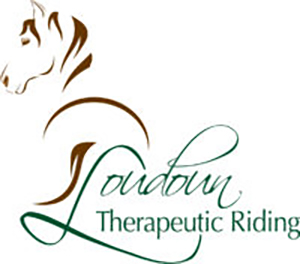
Loudoun Therapeutic Riding Foundation, Inc.
14490 Berlin Turnpike
LOVETTSVILLE, VA 20180
Mailing Address:
14490 Berlin Turnpike
LOVETTSVILLE, VA 20180
Phone: 703-771-2689
MAKE AN INQUIRY
View our WEBSITE
EIN: 23-7390594Founded: 1974
View our PHOTO GALLERY
Profile Last Updated July 30, 2025Public Charity
Click here to view listing(s) of the program horses we are seeking
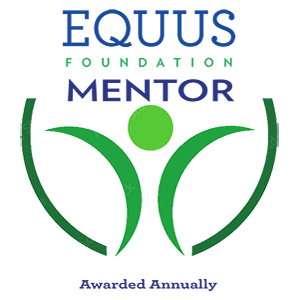
The Mentor Accreditation is awarded annually to an organization that operates at the highest standards for business and equine welfare practices in accordance with EQUUS Foundation guidelines for business and equine welfare practices outlined here.
We welcome you to donate directly to Loudoun Therapeutic Riding Foundation, Inc.; Loudoun Therapeutic Riding Foundation, Inc. will receive 100% of your donation made here. However, before making a donation, we encourage you to review this organization's Mentor information.
Last Updated: May 2, 2025

MISSION & PROGRAMS
Mission:Our Mission -
Loudoun Therapeutic Riding embraces the power of the horse and equine-assisted services to promote well-being and community inclusion for people with physical, cognitive, and mental health challenges.
Our organization conducts Equine Assisted Services in accordance with the EQUUS Foundation Guidelines on Qualifications of Organizations Conducting Equine Assisted Services (EAS).
Our organization provides outreach and/or public education programs involving horses.
100% of our total programs and services are equine-related.
Our organization is directly responsible for the care and shelter of equines involved in our programs.
Our organization does not CURRENTLY use satellite, overflow, foster, and/or outreach facilities.
Please describe what steps your organization takes to ensure that:
1) all interactions between your equines and people are mutually beneficial and conducted in accordance with the Guidelines for Human-Equine Interactions stated below;
2) all equines in the care of our organization and/or equines that participate in the organization's program have access to clean drinking water at all times; nutritious food in sufficient quantity, including natural forage such as pasture grass and/or hay; appropriate veterinary, farrier, and dental care; shelter and protection from the weather; sufficient safe space to move around comfortably on a daily basis; and daily opportunity to freely interact and have contact with other equines:
LTR, Inc. is a PATH Intl. Premier Accredited Center (PAC) and adheres to all codes of ethics with regard to the care of its horses (equines) and humans.
Our written Horse Management Policy was designed to describe the expectations for care for horses affiliated with LTR. The policy describes the proper stewardship of and use of equines involved with all center activities, including but not limited to therapeutic riding, therapeutic driving, hippotherapy, equine facilitated psychotherapy, equine assisted experiential learning. LTR adheres to the Accreditation Standards of the Professional Association of Therapeutic Horsemanship Intl (PATH Intl). Those standards have been established to promote safe and effective equine assisted activities and therapies. LTR further endeavors to keep the safety and well being of its horses a top priority. Therapeutic work can become physically and emotionally taxing for the horses. Therefore, LTR has developed this policy to ensure that the horses’ well being is monitored and their needs assessed regularly. The written document is part of our center manual, and a portion of the information contained within is below:
Handling and Management
Horses will be cared for and handled in such a way as to maximize their comfort and well being before, during, and after working sessions. (A “working session” is defined as a period of continuous use without any lengthy break.) This includes but is not limited to:
· Working sessions may not be longer than 3 continuous hours without a break.
· Equines will be used no more than 6 hours per day.
· Equines in HPOT may not be worked for more than 2 consecutive HPOT sessions per day. HPOT working session = ½ hour.
· Equines in HPOT may not work more than 2 total hours per day in HPOT sessions.
· Equines in HPOT will not be used for more than 2 consecutive days for HPOT sessions or more than 6 HPOT hours per week.
· During each working session, a PATH Intl. certified instructor or the therapist(s) will assess the horses for signs of lameness, stress, fatigue, and/or discomfort. Horses demonstrating behaviors classified as stress-related (i.e., repeated/ongoing head tossing, shaking or turning; ears pinned back; or other signs of nervousness or noncompliance with instructor or volunteer requests) will be removed from the therapeutic activity and returned to the stall or paddock for further observation.
· Horses will be physically warmed up before or at the start of working sessions, as necessary.
· Harnesses, saddles, or other equipment necessary for each session will be fitted to each horse to ensure even pressure and prevent injury; tack is checked by instructors at the start of and during each working session for proper fit and position.
· Horses will be handled only by appropriately trained horse handlers (staff or volunteers of LTR).
· Horses will be offered water at regular intervals or as necessary
· Horses will be returned to their stall and tack will be loosened or changed (if needed) between sessions.
· At the end of the day’s sessions, the horse will have tack removed and will be cleaned appropriately (e.g., brushed, sponged, hooves picked). The horse will then be returned to the stall or paddock.
Indoor Environment
The horses’ indoor environment shall be maintained in a safe state of repair and designed to allow appropriate freedom of movement:
· Stalls will be adequate for the horse to make normal postural adjustments and movements (i.e., standing up, lying down, turning around);
· Stall doors are large enough to allow the horse to enter safely and leave comfortably.
· Suitable, non-slip flooring materials (i.e., rubber mats, artificial turf, packed clay, gravel, etc.) are used in stalls and around the stable
· A sanitary environment is maintained and the horses do not have access to manure waste storage areas
· Horses will be placed in separate stalls, located based on temperament and social rank
· Stalls and ceiling height have been designed to allow for proper ventilation (i.e., windows, openings, fans) to decrease moisture, humidity, and stall odors, and to allow for visual contact between the horses to reduce isolation.
· Bedding is consistent with the comfort of the horse and facilitates adequate sanitation.
· Varied levels of lighting are continuously available to prevent injury and allow for adequate handling and inspection during feeding or other activities.
Outdoor Environment
Pastures and paddocks are chosen and maintained to be safe and pleasant areas in which LTR horses live. They are enclosed with safe fencing materials, contain a firm surface for standing (dry areas are available during muddy conditions), sufficient areas for normal postural adjustments, and have adequate sunshade and windbreak. Outdoor accommodations include adequate feed and water, allow for exercise, and give the horses freedom to roam. The sanitary conditions of the enclosures will be maintained so horses have minimal contact with excrement.
Nutritional Management and Exercise
Daily nutritional and management practices are employed to provide essential nutrients, maintain appropriate weight and body condition, and maintain health and welfare. Horses’ weight is regularly assessed by LTR staff and adjustments in feed/exercise regimen made accordingly to maintain healthy weight. Horses are exercised regularly by LTR staff or competent volunteer to maintain proper fitness for the work expected. Clean water is replenished as necessary, and available continuously in the barn and paddock areas.
Social Environment
Horses will have adequate opportunity for socialization. When not participating in therapeutic sessions, horses will be turned out in paddocks as much as possible to socialize with other horses. Horses will receive a minimum of 4 hours of free time during the day.
During “off” weeks when not used in therapeutic activities, they will be allowed as much turn out time as possible and will be ridden 1-2 times each week by an experienced rider.
General Care
Horses will be groomed regularly and carefully to ensure their ongoing good health and comfort and to minimize the risk of skin ailments/health problems that arise from inadequate grooming or excessive exposure to mud or manure.
Surveillance, Diagnosis, Treatment & Control of Disease
LTR horses are observed twice daily and on an ongoing basis to monitor their health and well-being during feeding, therapeutic activity, and during their “free time.” Abnormalities of concern are reported to the Assistant Program Director. Medical events, diagnoses, or concerns are noted in the horse’s health records. An outdoor camera provides visual access to several fields and the farm driveway.
Horses are vaccinated and dewormed regularly according to fecal float results, in consultation with a veterinarian’s recommendations. Horses are shod/trimmed at appropriate intervals, as necessary for equine husbandry in the region. Hooves are inspected and cleaned regularly, monitored for growth, and trimmed as necessary by LTR’s farriers.
Quarantine for sick horses will be carried out when the affected animal poses a risk to the resident herd. In the event of a communicable disease, the horse will be isolated in a separate stall and/or field. An integrated approach to vector control (i.e., sanitation procedures, elimination of insect breeding areas, use of pyrethroids) will be used to reduce the prevalence of flying insects.
Equine Assisted Services (EAS):
Our organization provides the following Equine Assisted Services (EAS):
Adaptive/Therapeutic Riding
Adaptive/Therapeutic Driving
Adaptive/Therapeutic Unmounted Horsemanship
Psychotherapy/Counseling
Occupational Therapy/Physical Therapy/Speech-Language Pathology
11: Total number of Equine Assisted Service Providers at Loudoun Therapeutic Riding Foundation, Inc.
1 Alison Duvall
FACILITY PARTICIPATION:
Loudoun Therapeutic Riding Foundation, Inc.
RELATIONSHIP: Employee
SERVICES PROVIDED:
Adaptive/Therapeutic Riding
Adaptive/Therapeutic Unmounted Horsemanship
DEGREES, LICENSES AND/OR CERTIFICATIONS
Bachelor of Art Degree
PATH Intl. Certified Therapeutic Riding Instructor (CTRI)
2 Caitlin Taft
FACILITY PARTICIPATION:
Loudoun Therapeutic Riding Foundation, Inc.
RELATIONSHIP: Employee
SERVICES PROVIDED:
Adaptive/Therapeutic Riding
Adaptive/Therapeutic Unmounted Horsemanship
DEGREES, LICENSES AND/OR CERTIFICATIONS
PATH INTL - CTRI
3 Catherine Coleman
FACILITY PARTICIPATION:
Loudoun Therapeutic Riding Foundation, Inc.
RELATIONSHIP: Independent Contractor
SERVICES PROVIDED:
Occupational Therapy/Physical Therapy/Speech-Language Pathology
DEGREES, LICENSES AND/OR CERTIFICATIONS
Catherine Coleman, Licensed Speech/Language Pathologist (SLP) PATH Intl. Registered Therapist
4 Catherine Wycoff
FACILITY PARTICIPATION:
Loudoun Therapeutic Riding Foundation, Inc.
RELATIONSHIP: Independent Contractor
SERVICES PROVIDED:
Adaptive/Therapeutic Riding
Adaptive/Therapeutic Unmounted Horsemanship
Occupational Therapy/Physical Therapy/Speech-Language Pathology
DEGREES, LICENSES AND/OR CERTIFICATIONS
Catherine Wycoff, PT, DPT, GCFP, HPCS and CTRI
5 Debbie Gerbich
FACILITY PARTICIPATION:
Loudoun Therapeutic Riding Foundation, Inc.
RELATIONSHIP: Employee
SERVICES PROVIDED:
Adaptive/Therapeutic Riding
Adaptive/Therapeutic Unmounted Horsemanship
DEGREES, LICENSES AND/OR CERTIFICATIONS
CTRI
6 Dylan Beckner, LCSW (Beckner Counseling
FACILITY PARTICIPATION:
Loudoun Therapeutic Riding Foundation, Inc.
RELATIONSHIP: Independent Contractor
SERVICES PROVIDED:
Psychotherapy/Counseling
DEGREES, LICENSES AND/OR CERTIFICATIONS
Dylan Beckner, LCSW (Beckner Counseling) is the licensed mental health therapist who provides this service.
7 Jennifer Johnson
FACILITY PARTICIPATION:
Loudoun Therapeutic Riding Foundation, Inc.
RELATIONSHIP: Employee
SERVICES PROVIDED:
Adaptive/Therapeutic Riding
Adaptive/Therapeutic Driving
Adaptive/Therapeutic Unmounted Horsemanship
DEGREES, LICENSES AND/OR CERTIFICATIONS
PATH Intl. Certified Therapeutic Riding Instructor (CTRI)
PATH Intl. Certified Level 1 Driving Instructor
8 Kathy Blaine
FACILITY PARTICIPATION:
Loudoun Therapeutic Riding Foundation, Inc.
RELATIONSHIP: Employee
SERVICES PROVIDED:
Adaptive/Therapeutic Riding
Adaptive/Therapeutic Driving
Adaptive/Therapeutic Unmounted Horsemanship
DEGREES, LICENSES AND/OR CERTIFICATIONS
PATH Intl. Registered Instructor, CTRI, PATH Intl. Equine Specialist in Mental Health and Learning, BA. Note: Kathy Blaine is the able-bodied whip (ABW) and drives with students in the vehicle with Mary Jo Beckman (PATH Certified Driving Instructor) supervising the lesson. Kathy accumulated the required 50+ hours of driving experience. This is allowed per PATH driving standard DA11 MANDATORY.
*DA11 MANDATORY
Is there an implemented procedure for the Professional Association of Therapeutic Horsemanship International Certified Driving Instructor to verify the driving qualifications of the ABW to include but not be limited to the following:
1. Is 18 years of age or older? Yes
2. Has at least 50 hours of experience driving equines in varied settings? Yes
3. Is trained in the use of the second set of reins and in assisting the participant while driving, if needed? Yes
Interpretation: Competency of the ABW is vital. The ABW should also have good upper body strength and drive regularly in addition to the session within the program.
9 Kendall Zywiak
FACILITY PARTICIPATION:
Loudoun Therapeutic Riding Foundation, Inc.
RELATIONSHIP: Employee
SERVICES PROVIDED:
Adaptive/Therapeutic Riding
Adaptive/Therapeutic Unmounted Horsemanship
DEGREES, LICENSES AND/OR CERTIFICATIONS
PATH Intl. CTRI
BS - Centenary University (Bachelors Degree/Equine-assisted Services)
10 Mary Jo Beckman
FACILITY PARTICIPATION:
Loudoun Therapeutic Riding Foundation, Inc.
RELATIONSHIP: Employee
SERVICES PROVIDED:
Adaptive/Therapeutic Riding
Adaptive/Therapeutic Driving
Adaptive/Therapeutic Unmounted Horsemanship
DEGREES, LICENSES AND/OR CERTIFICATIONS
CTRI; PATH Intl. Master Instructor; PATH Intl. Level 1 Certified Driving Instructor
11 Merriam Mashatt
FACILITY PARTICIPATION:
Loudoun Therapeutic Riding Foundation, Inc.
RELATIONSHIP: Employee
SERVICES PROVIDED:
Adaptive/Therapeutic Riding
Adaptive/Therapeutic Unmounted Horsemanship
DEGREES, LICENSES AND/OR CERTIFICATIONS
PATH Intl. CTRI and Equine Specialist in Mental Health & Learning
12 Rachel Doyle
FACILITY PARTICIPATION:
Loudoun Therapeutic Riding Foundation, Inc.
RELATIONSHIP: Employee
SERVICES PROVIDED:
Adaptive/Therapeutic Riding
Adaptive/Therapeutic Unmounted Horsemanship
DEGREES, LICENSES AND/OR CERTIFICATIONS
Rachel Doyle - BS in Equine Facilitated Therapeutics/Wilson College. She is a PATH Intl. Certified Therapeutic Riding Instructor & an Equine Specialist in Mental Health and Learning (CTRI & ESMHL) PATH Member #6929200
Overview of our programs involved with providing EAS to individuals with special needs:
Loudoun Therapeutic Riding, Inc. Services for people with diverse needs include but not limited to the following:
PTSD
Learning Disabilities
Developmental Delay
Autism
Down Syndrome
Hearing/Visually Impairment
Cerebral Palsy
Traumatic Brain Injury
Muscular Dystrophy
Multiple Sclerosis
Stroke
Psychological or Behavioral Challenges
Equine Assisted Services:
1. Therapeutic Riding TR (taught or supervised by PATH Intl/Certified Therapeutic Riding Instructors) Description: Therapeutic riding is an equine assisted service that promotes the cognitive, physical, emotional and social well-being of individuals. We partner with our horses to create a program that fosters a community environment with inclusion, respect and working towards independence.
Therapeutic (adaptive) riding is widely recognized as beneficial for people with diverse needs. The riding component helps develop self-awareness, build self-confidence, improve concentration, increase self-discipline, strengthen and relax muscles, improve posture and so much more. Off the horse, therapeutic horsemanship also improves confidence, attitude, and self-image by mastering new skills. Working towards these goals, students improve their function in all activities of their lives. For riders with cognitive or emotional challenges, the relationships formed with the horse, staff, and volunteers also have therapeutic benefits.
2. Therapeutic Carriage Driving TD (all driving lessons taught by a PATH Intl. Certified Therapeutic Driving Instructor) Student goals include grooming, horsemanship, harnessing and carriage driving skills. Description:
In addition to riding and horsemanship lessons, Loudoun Therapeutic Riding offers a carriage and cart driving program for those participants who cannot, or choose not to sit, astride a horse, yet can still benefit from the interaction with the horse and the equine activity. The driving program develops communication skills, improves gross and fine motor skills, builds self-confidence, self-awareness, trust, and encourages students to form positive relationships in a socially and sensory rich environment.
LTR even has a one-of-a-kind adaptive carriage that is wheelchair accessible, generously donated to us in 2013. This unique carriage allows us to provide quality services to individuals needing convenient and safe access the carriage.
3. Therapeutic Unmounted Services (Horse-powered Learning): ground-work in grooming, horse care and behavior, stable management, horsemanship, etc. (taught or supervised by PATH Intl. Certified Therapeutic Riding Instructors or an ESMHL) Description: These classes typically take place in the barn and sometimes the arena. Special group tours or higher education practicums and modules are offered periodically. These un-mounted sessions are supervised by a CTRI - ESMHL LTR staff member for the purpose of providing educational opportunities to students or individuals requiring training in horse handling, first aid, horsemanship or EAS in general.
4. Physical Therapy/Speech Therapy - is conducted by a licensed physical therapist or speech therapist with a PATH Intl. Certified Therapeutic Riding Instructor present. Description: Physical therapy (incorporating Hippotherapy as a treatment tool). Occupational therapy, physical therapy, and speech-language pathology professionals use evidence-based practice in the purposeful manipulation of equine movement to engage sensory, neuromotor, and cognitive systems to achieve functional outcomes. In conjunction with other treatment strategies, hippotherapy is part of a patient’s integrated care plan. **NOTE: This service is paused until summer 2025**
As a treatment tool, each step of the horse, when carefully integrated into a treatment plan by a trained therapist, has the potential to produce a powerful neuromotor input that can help the patient improve their function and get closer to their treatment goal. The therapist directs the movement of the horse; analyzes the patient’s responses, and adjusts the treatment accordingly.
5. PATH Intl. Equine Services for Heroes – Program serving wounded military/veterans and may include riding, carriage driving or ground lessons. (Conducted by PATH Intl. Certified Instructors.) Description: Highly experienced and trained personnel facilitate quality equine assisted services for veterans.
As a PATH Int’l Premier Accredited Center, LTR is proud to offer its Equine Services for Heroes program to veterans at no direct cost to the veteran or the veteran's family.
In response to the growing need for therapeutic opportunities for veterans, the Equine Services for Heroes program uses equine assisted services to aid wounded warriors in recovery. Participants of the program often have diagnoses like Post Traumatic Stress Disorder (PTSD) or traumatic brain injury (TBI), both of which can have global effects on physical, cognitive, social, emotional, and behavioral health.
6. Equine Assisted Psychotherapy - LTR introduced an Equine Assisted Psychotherapy program in 2024 which will be conducted by Dylan Beckner, LCSW, Beckner Counseling, to further meet the needs of the community.
With the help of our equine partners, we provide these individuals the opportunity to regain valuable skills lost due to injury or trauma in a safe and supportive environment.
Outreach and/or Public Education:
Pony Tales Program
This service is geared toward community engagement at local libraries through visits and stories with an LTR equine to promote program awareness, education and collaboration.
Silver Spurs Program
This service is offered to seniors/elderly residents living in memory care or in assisted living facilities. Participants come to the farm for unmounted time with our equines learning to groom, doing arts or crafts and spending time outside connecting with staff and volunteers. There are sometimes offsite visits to residential facilities for our official ambassador equines greet people where they live. A PATH Intl. certified staff member always supervises these visits. LTR received another grant to continue this importance service in 2025.
Research/Medical Use of Equines:
Our organization has never made, and would not ever consider making, equines available for research studies or medical training that involves invasive procedures and/or that which may cause pain or suffering to the equine.
Religious Affiliation:
Our organization does not promote religious education, religious purposes, or a specific religious faith or use donations for religious education or religious purposes; require participants to be of a certain faith; require participation in religious, instruction, activities or services; or require participation in prayer, worship, religious instruction or other religious activities as a condition of receiving social or secular services offered.
Auction Donation:
Our organization has never allowed, or would not consider allowing, an equine to be sold, transferred, released, or otherwise placed into possession of any person or organization that would cause or allow the equine to be sold at auction for slaughter.
Our Programs/Activities that are not equine-related and/or involving animals other than equines:
Educational opportunities for therapeutic riding instructor candidates, therapists and volunteers.
POLICIES: INTAKE, ASSESSMENT & TRAINING
Prior to a horse being accepted and/or arriving at the facility, the organization has the following policies in place:The owner of a potential equine is interviewed over the phone or in person prior to seeing the equine
The equine is evaluated at its place of residence
The owner completes an application/contract which constitutes the agreement between the owner and our organization when the equine is acquired from the equine's owner other than by seizure or by abandonment
The owner is financially responsible for the shipping of the equine to and from the organization
If health records are not available or are out-of-date, our veterinarian will administer appropriate vaccinations
A health certificate signed by a veterinarian and dated no more than seven days prior to arrival is provided to our organization either prior to or upon arrival of the equine attesting to the health status of the equine
Trial Period: Check all that apply:
Equines are on trial for 60 or more days
The trial period may be reduced based on the equine's progress
During the trial period, the organization accepts financial responsibility for the care of the equine, including board, feed, shoeing and any necessary veterinary care, up to a fixed amount agreed upon by the organization and the owner
The trial period may be terminated by either the organization or the owner for any reason
Equines are on trial for up to 30 days
Equines are on trial up to 60 days
During the trial period, the organization accepts total financial responsibility for the care of the equine, including board, feed, shoeing and any necessary veterinary care
During the trial period, the owner/donor is financially responsible for the care of the equine, including board, feed, shoeing and any necessary veterinary care
Upon intake, the organization has the following quarantine policy in place:
The equine is confined to a designated and separate area for isolation and quarantine at the facility for a prescribed period of time
The equine is confined to a designated and separate area for isolation and quarantine off-site for a prescribed period of time
The equine is not quarantined
The typical length of quarantine is: 20 to 30 days
Following arrival of the equine at the facility, the following is performed:
Physical examination to include temperature, pulse and respiration by a veterinarian upon arrival
Physical examination to include temperature, pulse and respiration by a trained staff member upon arrival
A Henneke Body Conditioning Score or other body conditioning score is assigned by a veterinarian upon arrival
Photographs are taken of each equine upon arrival at the facility and kept with the equine's health records
Physical examination by a farrier
Physical examination by a dentist
A Henneke Body Conditioning Score or other body conditioning score is assigned by a trained staff member upon arrival
The equine is microchipped if the equine has not been microchipped
Horses are assessed for following skills and behaviors:
Retrieval from a pasture/paddock
Leading with a halter and lead rope
Temperament, disposition and attitude, such as rated from very calm to very high spirited
Saddling
Bridling
Lunging
Loading onto and unloading off a trailer
Mounting and dismounting
Riding at the walk
Riding at the trot
Riding at the canter
Riding by a beginner and/or unbalanced rider
Driving (Pulling a carriage)
Tolerance to unusual objects and loud noises
Known vices, i.e., cribbing, biting, kicking, weaving, stall walking, etc
Grooming
Bathing
Clipping
Tolerance to multiple handlers at the same time
Jumping
Our organization has the following policies and procedures in place pertaining to the ongoing assessment of horses in its care:
Physical examination by a veterinarian at least annually
The Henneke Body Condition score or other body conditioning score is updated at least annually by the veterinarian
Vaccinations are administered at least annually
Photographs are taken of each equine annually and kept with the equine's health records
Equines at our facility may be treated by an equine chiropractor
Equines at our facility may be treated by an equine acupuncturist
Equines at our facility may be treated by an equine massage therapist
Equines at our facility may be treated by an equine nutritionist
The Henneke Body Condition score or other body conditioning score is updated at least annually by a trained staff member
Photographs are taken of each equine monthly and kept with the equine's health records
Our organization has the following policies and procedures in place pertaining to the weight-carrying or workload capabilities of horses/equines that are ridden in our care:
Our organization evaluates the weight-carrying and workload limitations for each equine that is ridden at least annually
Our organization maintains a written record of the weight-carrying and workload limitations for each equine that is ridden
Our organization does not evaluate the weight-carrying and workload limitations for each equine that is ridden
No equines are ridden; not applicable
The following variables are considered in determining the weight-carrying and workload limitations for each equine that is ridden:
Equine age, weight, breed, body condition, fitness, balance, health and soundness
Equine conformation to include the top line, length of back, strength and width of loin, bone density (measured by the circumference of the cannon bone just below the knee)
Size, shape, condition and angle of the hooves
Participant weight, height, body proportions, balance, fitness and riding skills as well as behavioral issues and safety concerns
Weight and proper fit of the saddle and other equipment
Terrain and footing in the working environment
Duration and frequency of working sessions, as the frequency with which an equine is subjected to maximum weight carrying and/or workload
Nature and pace of work, repetitive or varied, radius of turns, degree of incline and regularity of footing when equine is subject to maximum weight-carrying capacity
Temperature and/or weather conditions
Seasonal impact on the equines' workload and weight-carrying capabilities and limitations
Our organization does not evaluate the weight-carrying and workload limitations for each equine that is ridden
No equines are ridden; not applicable
Horses provided formal training (groundwork or riding): 2-3 times per week
Additional information about our intake, assessment & training policies and practices:
A Henneke Body Condition Score is assigned to each of our horses. We carefully assess the weight and condition of each horse and photograph each horse on arrival at our center, and then upload the photos to each individual horse's profile. Photographs are regularly taken after the equine has joined the team.
Our herd is evaluated regularly by our veterinarian, and each horse's weight/condition is evaluated regularly using the standard weight tape method. LTR supports our local community college's veterinary technology student program twice a year where all herd members are assessed for overall health, weight, condition, appearance, and attitude. Findings are then updated in each horse's online platform profile.
Same policy 2025
POLICIES: BREEDING
The organization has the following policies related to breeding and stallions:Our organization does not conduct breeding of equines owned or under the care of our organization.
Our main facility where our organization conducts its programs does NOT breed equines.
One or more of the facilities where our organization conducts its programs, including foster/temporary care facilities, breeds equines
One or more of the facilities where our organization conducts its programs, including foster/temporary care facilities, are permitted to house stallions
Additional information about our breeding policies and practices:
No breeding.
POLICIES: EUTHANASIA
The organization has the following policies related to euthanasia:Our organization will never have an equine euthanized for space
Our organization will have an equine euthanized upon the recommendation of the veterinarian if the equine is a threat to itself, other equines, or people
Our organization will have an equine euthanized upon the recommendation of the veterinarian after all reasonable treatment options have been explored
Euthanasia is done on site when possible to decrease trauma from transport
Disposal of the carcass is handled within 24 hours
Our organization will never have an equine euthanized under any circumstances
Euthanasia is done at the veterinarian's facility
The following are authorized to administer the procedure for your organization in accordance with state laws:
Veterinarian
A certified euthanasia technician
Senior staff with appropriate training
Employee of animal control shelter or humane society with appropriate training
Veterinary student under the supervision of a licensed veterinarian
Not applicable. Our organization prohibits euthanasia under any circumstances
Additional information about our euthanasia policies and practices:
Same policy - 2025
POLICIES: RE-HOMING
View Re-homing AgreementOur organization has the following re-homing (adoption/purchase) policies and procedures in place:
All potential adopters/purchasers complete a written contract which constitutes the agreement between our organization and the new owner
Our organization does NOT re-home an equine to first time equine owners
Our organization will only re-home an equine to a location where another equine resides
Potential adopters/purchasers must visit our organization and be observed with the equine on site
The distance of a potential adopter/purchaser's home from our facility is a consideration for when re-homing an equine
Our organization conducts a site visit of the adopter/purchaser's facility before the transfer of the equine to the adopter/purchaser's facility
Potential adopters/purchasers are encouraged to do a short-term, on-site foster with the equine
Adopters/purchasers are NOT required to provide updates
Our organization has the following policies and procedures related to horses that need to be retired, are no longer able to contribute to the mission of the organization, and/or are no longer manageable:
Equines may remain at our organization for their lifetimes
Equines may be found suitable homes by our organization
Equines may be returned to their owners
In the case an equine is unmanageable and demonstrates repeated dangerous behaviors, the equine may be euthanized upon the recommendation of the veterinarian
In the case an equine is unsound and/or unhealthy and cannot be treated to relieve suffering, the equine may be euthanized upon the recommendation of the veterinarian
The organization will accept financial responsibility for equines in the current care of the organization that need to be retired or are no longer able to contribute to the mission of the organization if all alternatives have been explored to find the equine an appropriate placement and space is not available for the equine to remain at the organization.
Equines may be sent to auction
If a suitable home cannot be located within 12 months, the equine may be euthanized
The uploaded Re-homing agreement includes the following re-homing (adoption/purchase) statements:
The agreement states that the re-homed equine CANNOT be sold, adopted, transferred, auctioned, released, given away, or otherwise placed into the possession of another individual or organization under any circumstances and must be returned to our organization should the adopter decide that he/she is no longer able, or no longer wishes, to care for the equine.
The agreement reflects that any individual or organization in possession of the equine as of the date of the agreement and any time thereafter is bound to not sell the equine at auction for slaughter or allow the equine to be sold, transferred, released, or otherwise placed into possession of any person or organization that will cause or allow the equine to be sold at auction for slaughter.
The agreement states that re-homed equines cannot be bred
The agreement states that if there is any breach of contract the equine must be returned to our organization
The agreement states that our organization reserves the right to make scheduled visits
The agreement states that adopters/purchasers can return an equine to our organization free of charge
The agreement states that adopters/purchasers can return an equine to our organization for a fee
The agreement states that should the adopter decide to re-home the equine, the adopter must grant the organization first right of refusal prior to the equine being placed into the possession of any individual or organization intending to take possession of the equine for any reason.
The agreement states that should the adopter decide to re-home the equine, our organization must be notified of the name, address, and telephone number of any individual or organization intending to take possession of the equine for any reason prior to the equine being placed into the possession of such individual or organization.
The agreement states that should the adopter decide to re-home the equine, our organization must grant approval of any individual or organization intending to take possession of the equine for any reason prior to the equine being placed into the possession of such individual or organization, including being provided written notification of the name, address, and telephone number of any individual or organization intending to take possession of the equine for any reason.
The agreement states that the terms of our organization's agreement will be binding on any future individual or organization taking and/or in possession of the equine for any reason.
The agreement states that our organization reserves the right to make unannounced visits
The agreement states that adopters/purchasers are required to provide updates (photos, vet records) for one year
The agreement states that adopters/purchasers are required to provide updates (photos, vet records) for two years
Our organization microchips all equines that are not already microchipped before the adoption and/or transfer of the equine if the organization has the authority to microchip the equine.
The agreement includes the microchip number of the equine.
The agreement states that adopters/purchasers are required to provide updates (photos, vet records) for as long as the adopter/purchaser is responsible for the care of the equine
None of the statements are included.
The organization does not re-home equines under any circumstances; our organization retains custody of our equines and ensures care of the equines for their lifetimes.
Our organization does not have the authority to transfer ownership and/or does not own any of the equines involved with our programs.
Our organization requires references from the following:
Veterinarian
Farrier
Personal/Other
Not applicable or no references required.
Transfer of ownership occurs: Our organization retains ownership of the equine for its lifetime
The average equine re-homing (adoption/purchase) fee received by your organization:
None received
Additional information about our rehoming policies and practices:
Nearly all re-homed horses or ponies are returned to the owner if free-leased or to the donor if donated originally. The lease agreement and re-homing (retirement) agreement are attached. Agreement remains the same.
EQUINE CARE & SHELTER/FACILITY INFORMATION
Our organization does not CURRENTLY use satellite, overflow, foster, and/or outreach facilities.Total facilities at which our organization cares for and shelters horses used in our programs: 1
Loudoun Therapeutic Riding Foundation, Inc.
14490 Berlin Turnpike Lovettsville VA 20180
Currently operational
Total number of horses/equines currently involved with your programs, under your care, and/or owned by your organization at this facility: 14
Total number of horses at this facility NOT INCLUDING those counted above: 0
Maximum capacity of horses at this facility: 17
Does your organization own, lease or use a part of this facility? Own
Provide the contact information for the individual or organization responsible for investigating abuse in the county where the facility is located, including mailing address, email address, and phone information.
Loudoun County Virginia - Report abuse info: 703-777-1021 The S.A.V.E program was developed by Loudoun County Animal Services (LCAS) to facilitate the community’s recognition and understanding of the dynamic connection between animal abuse and the cycle of family and societal violence. Our goal is to combat violence in the home through a multi-discipline approach to ensuring the safety of humans and animals alike by focusing on the important role animals play, not only as victims but also therapeutic mediums teaching empathy and providing familial stability.
Does your organization conduct Equine Assisted Services (EAS) at this facility in accordance with the EQUUS Foundation Guidelines on Qualifications of Organizations Conducting Equine Assisted Services (EAS)? Yes
Total number of Equine Assisted Service Providers AT THIS FACILITY, including instructors, specialists, therapists, counselors, coaches and/or facilitators (full-time, part-time, volunteer, independent contractors, and/or providers accompanying clients) that conduct Equine Assisted Services (EAS) in accordance with the EQUUS Foundation Guidelines on Qualifications of Organizations Conducting Equine Assisted Services (EAS) AT THIS FACILITY: 11
Equine Assisted Service Providers Assigned to this Facility: (see Equine Assisted Service Provider Section below for details)
1. Alison Duvall
2. Caitlin Taft
3. Catherine Coleman
4. Catherine Wycoff
5. Debbie Gerbich
6. Dylan Beckner, LCSW (Beckner Counseling
7. Jennifer Johnson
8. Kathy Blaine
9. Kendall Zywiak
10. Mary Jo Beckman
11. Merriam Mashatt
12. Rachel Doyle
11 -> 12 - The total number of Equine Assisted Service Providers entered for this facility does not match the number of Equine Assisted Service Providers assigned to this facility under in the Equine Assisted Service Provider Section
There is double fencing along driveway and road.
LTR has a tenant living in an onsite apartment. This person is able to assess or monitor equines overnight. There is also a Ring camera on the front fields.
Veterinarian Information: Loudoun Therapeutic Riding Foundation, Inc. (*Main) Currently operational
Veterinarian: Jay Joyce, DVM
Clinic Name: Total Equine Veterinary Associates
41580 Sunday Morning Lane
Leesburg VA 20176
Phone: 703-505-2320
Grounds: Loudoun Therapeutic Riding Foundation, Inc. (*Main) Currently operational
Total acreage dedicated specifically to the horses: 25
Our organization has use of the following at this facility:
Structures/Barns: 1 Run-in sheds: 7
Pastures: 6 Paddocks/Pens/Turnout Areas: 5
Uncovered Outdoor Rings: 1 Covered Outdoor Rings: 0 Indoor Rings: 1

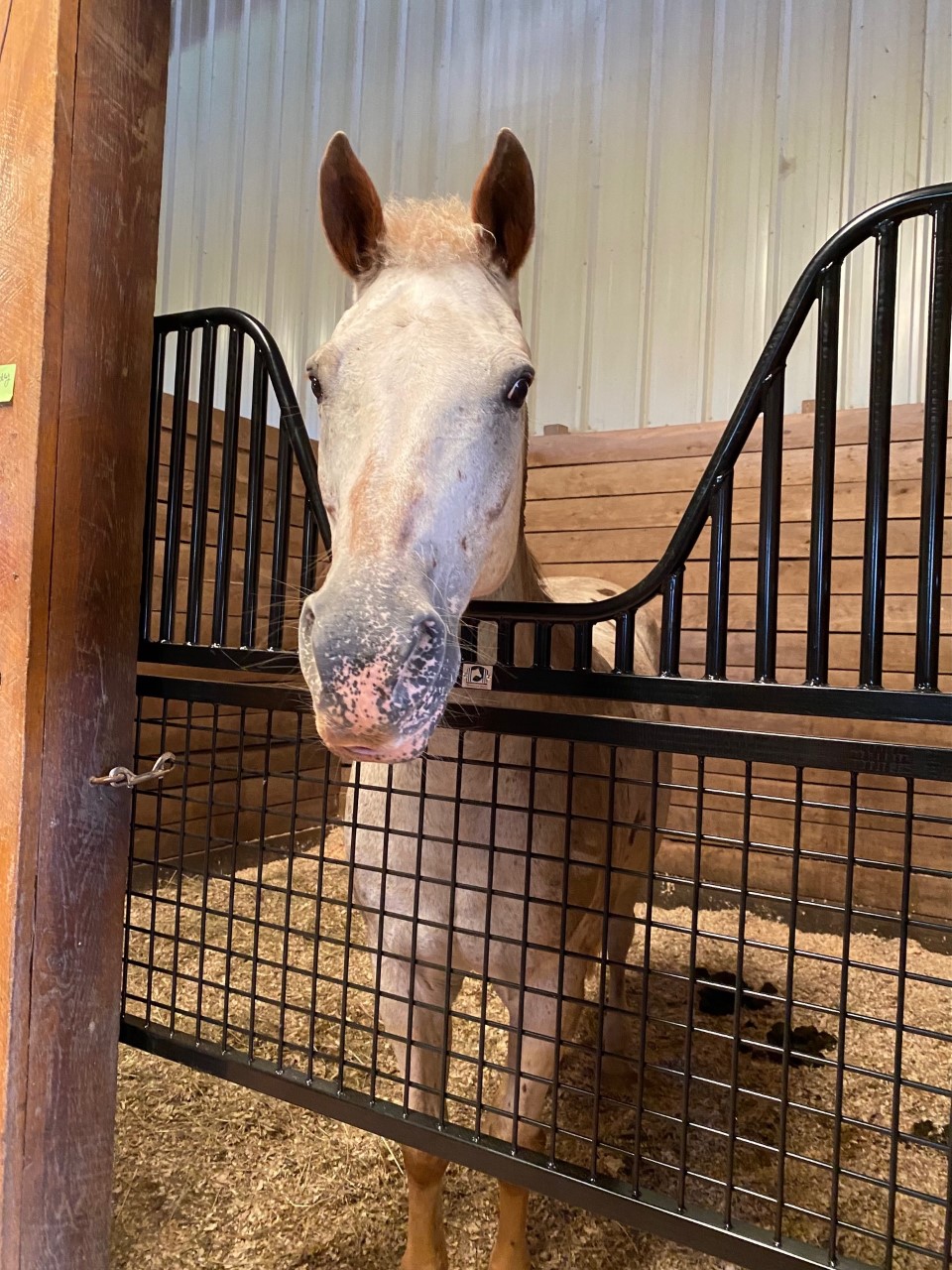
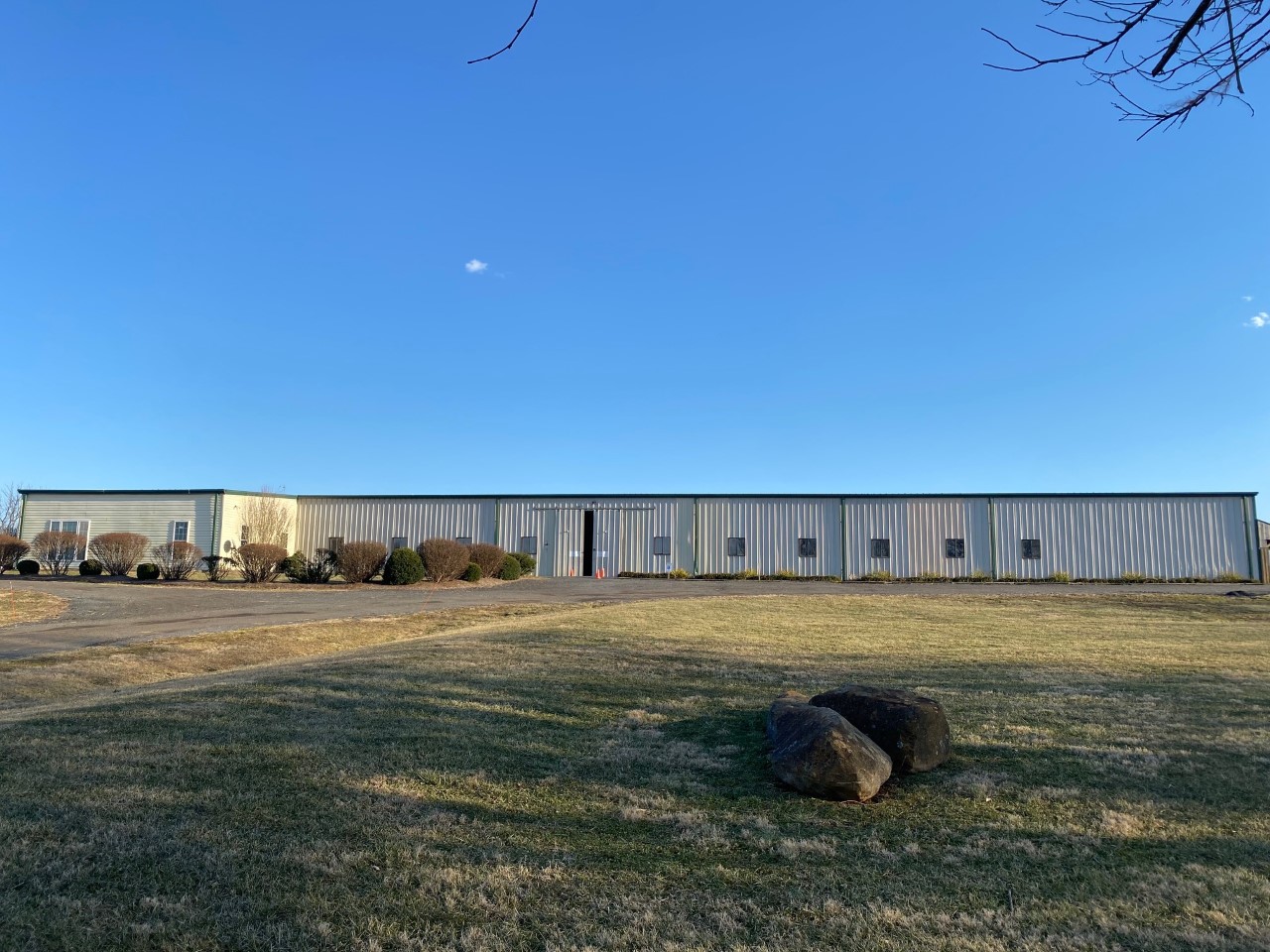
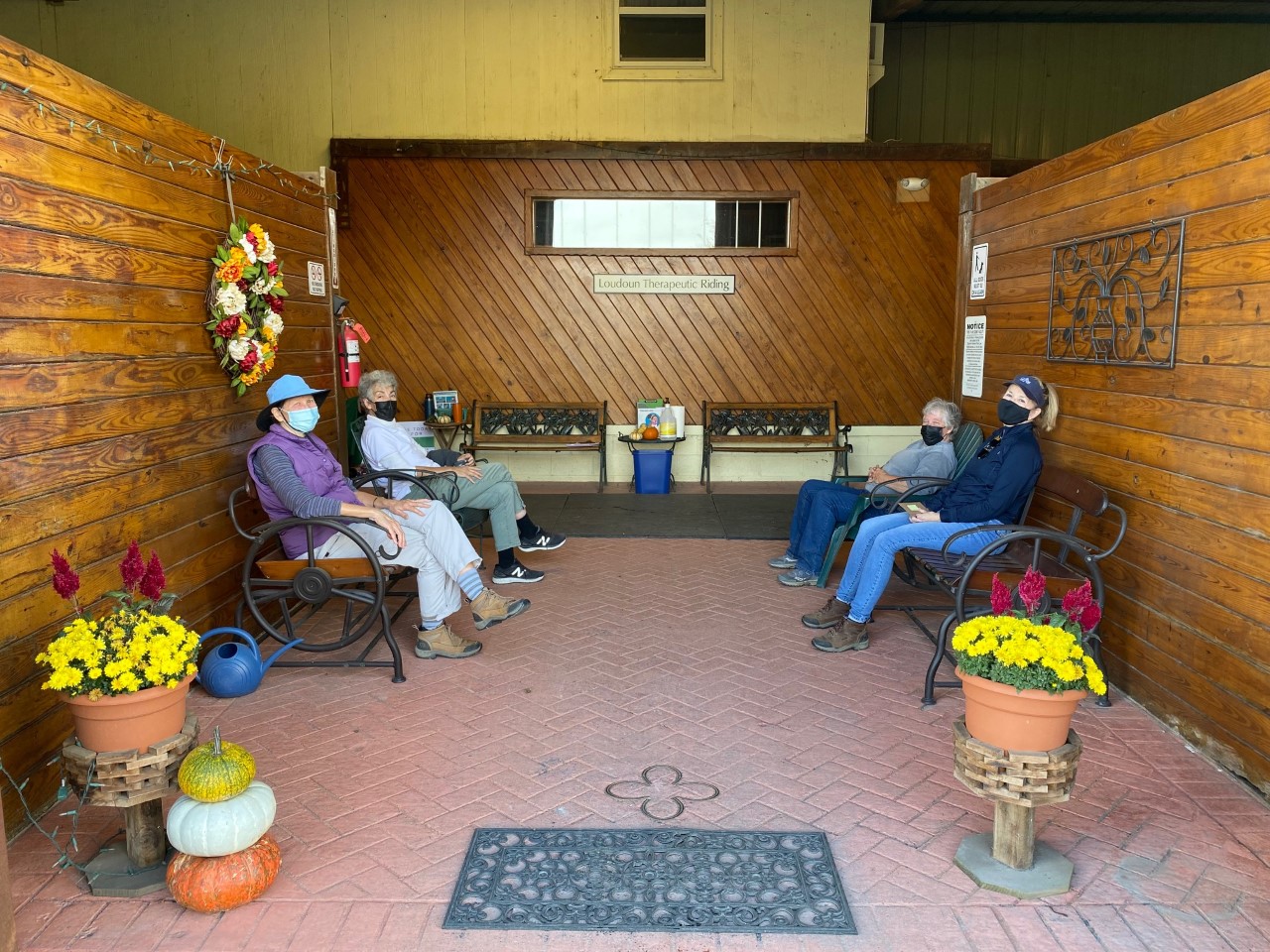

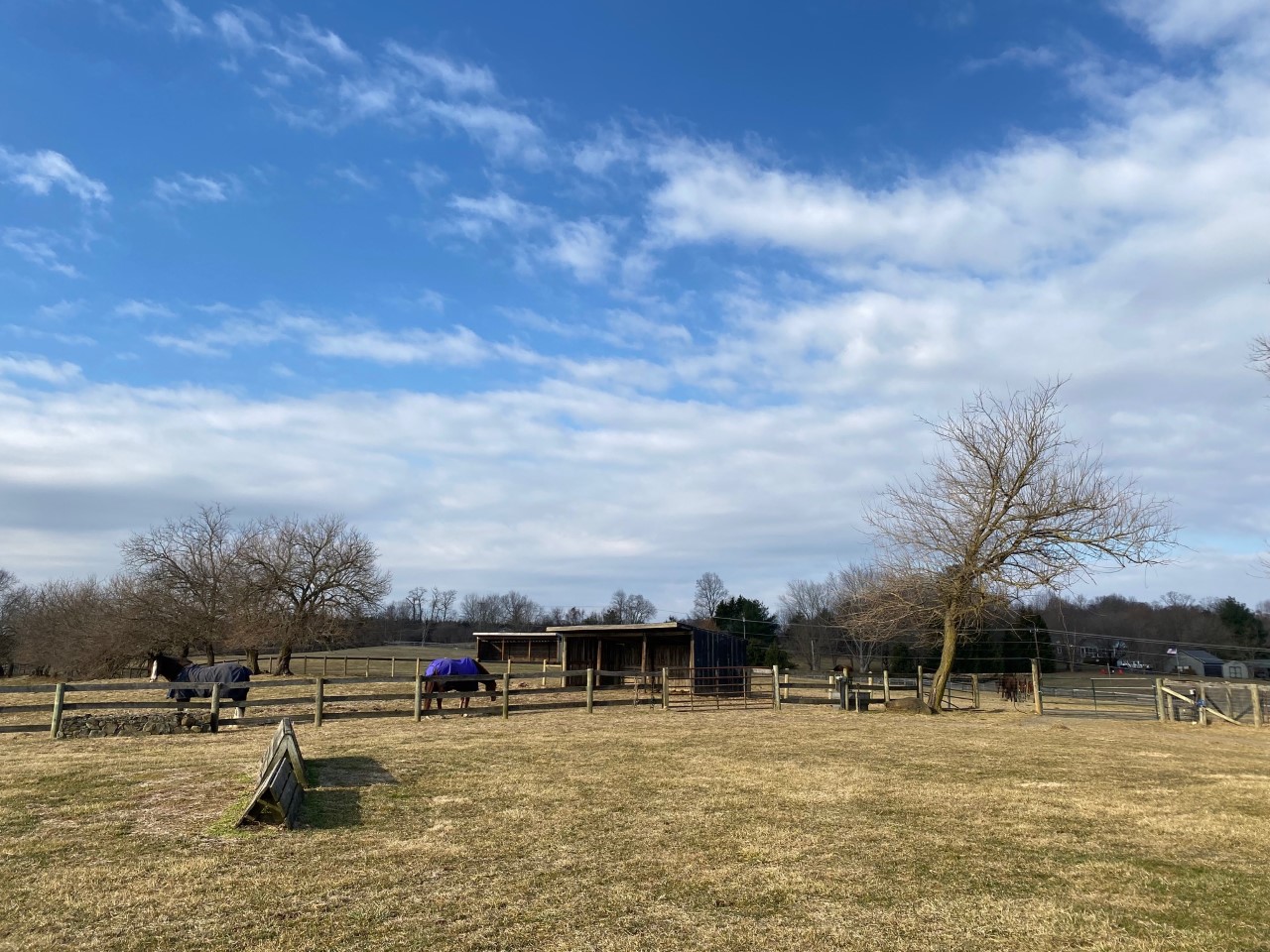

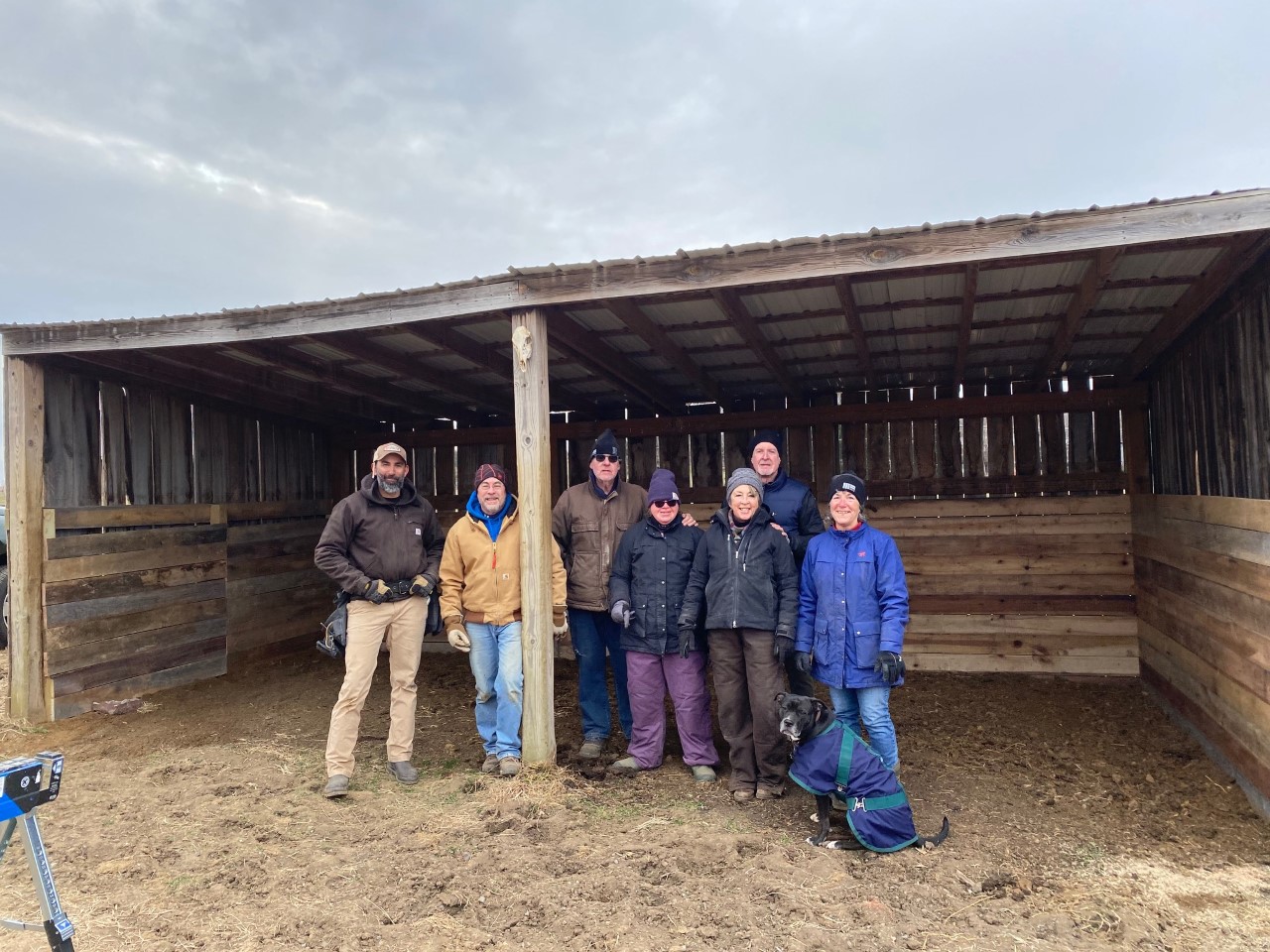
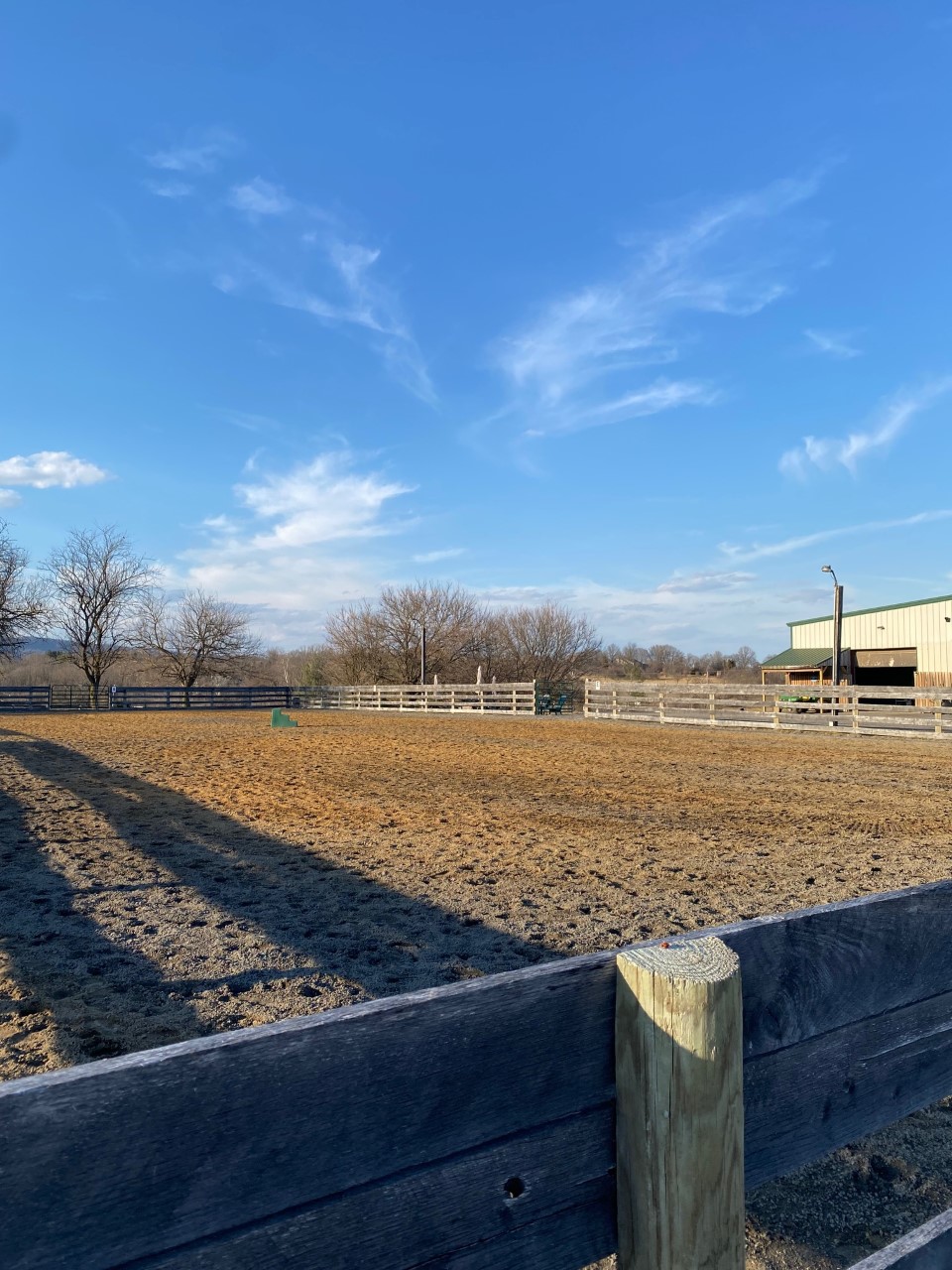
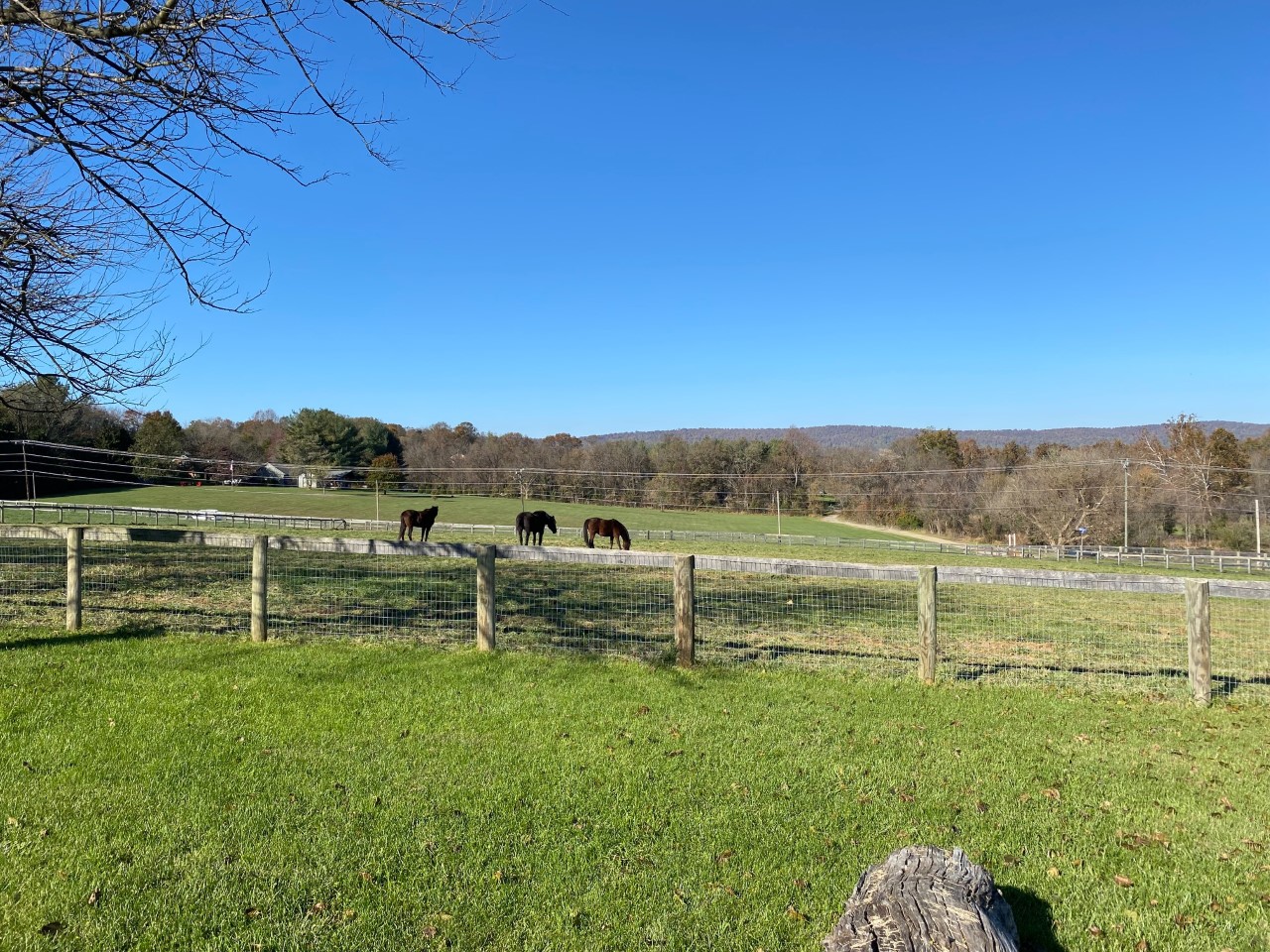
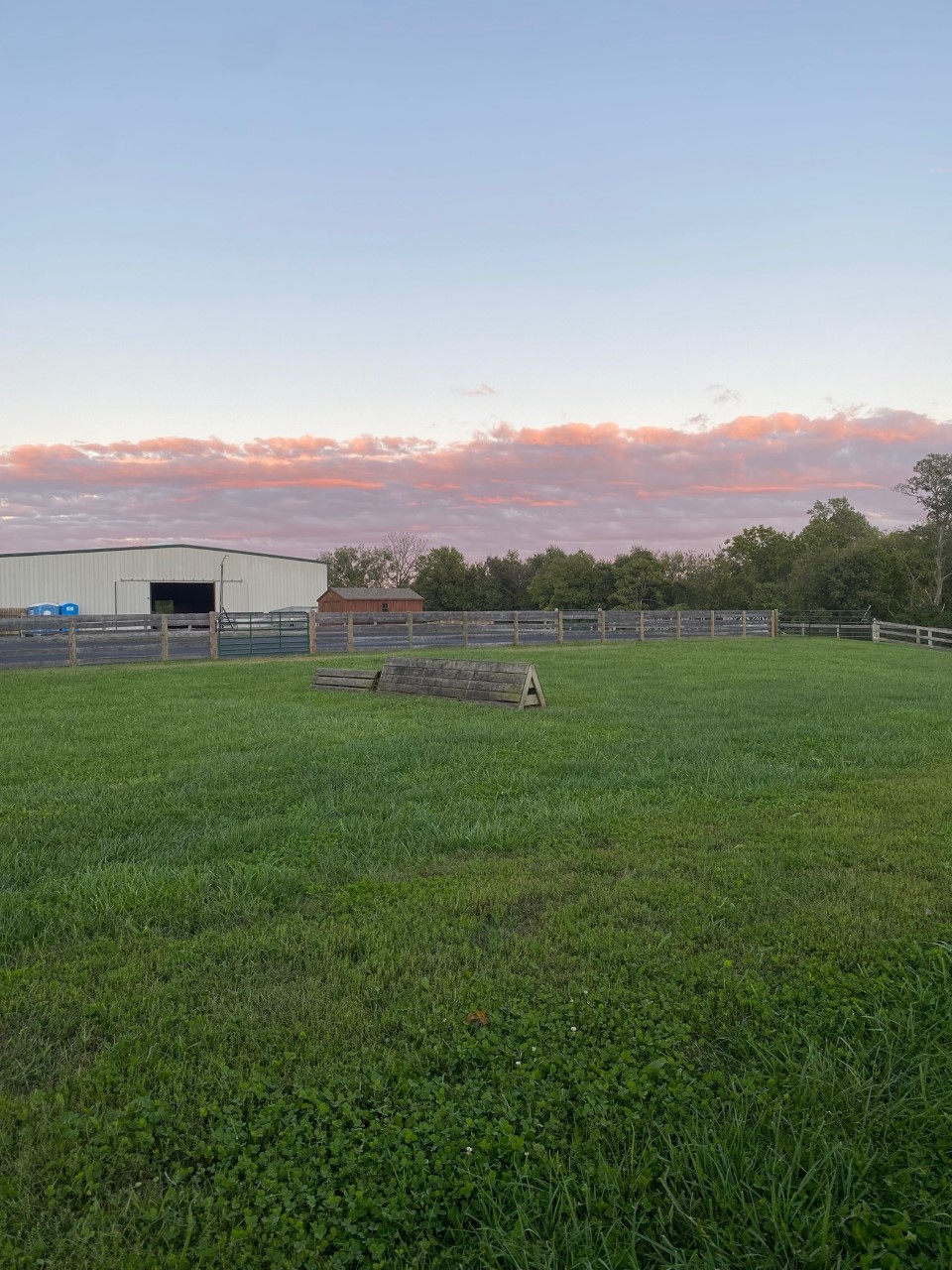
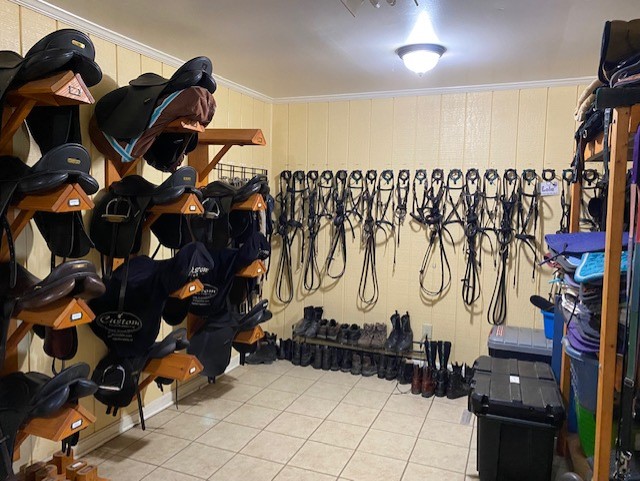
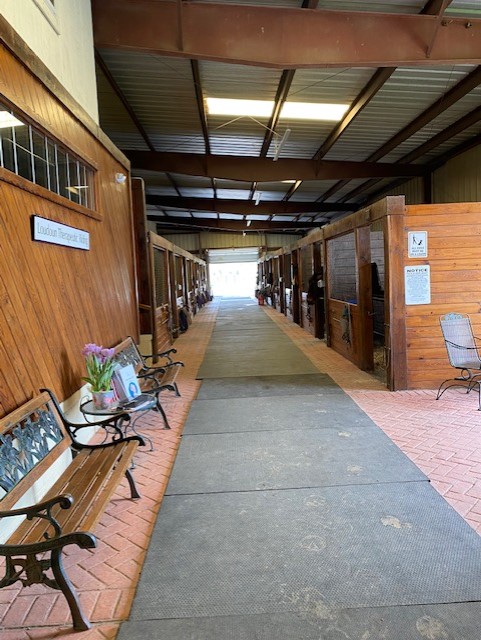

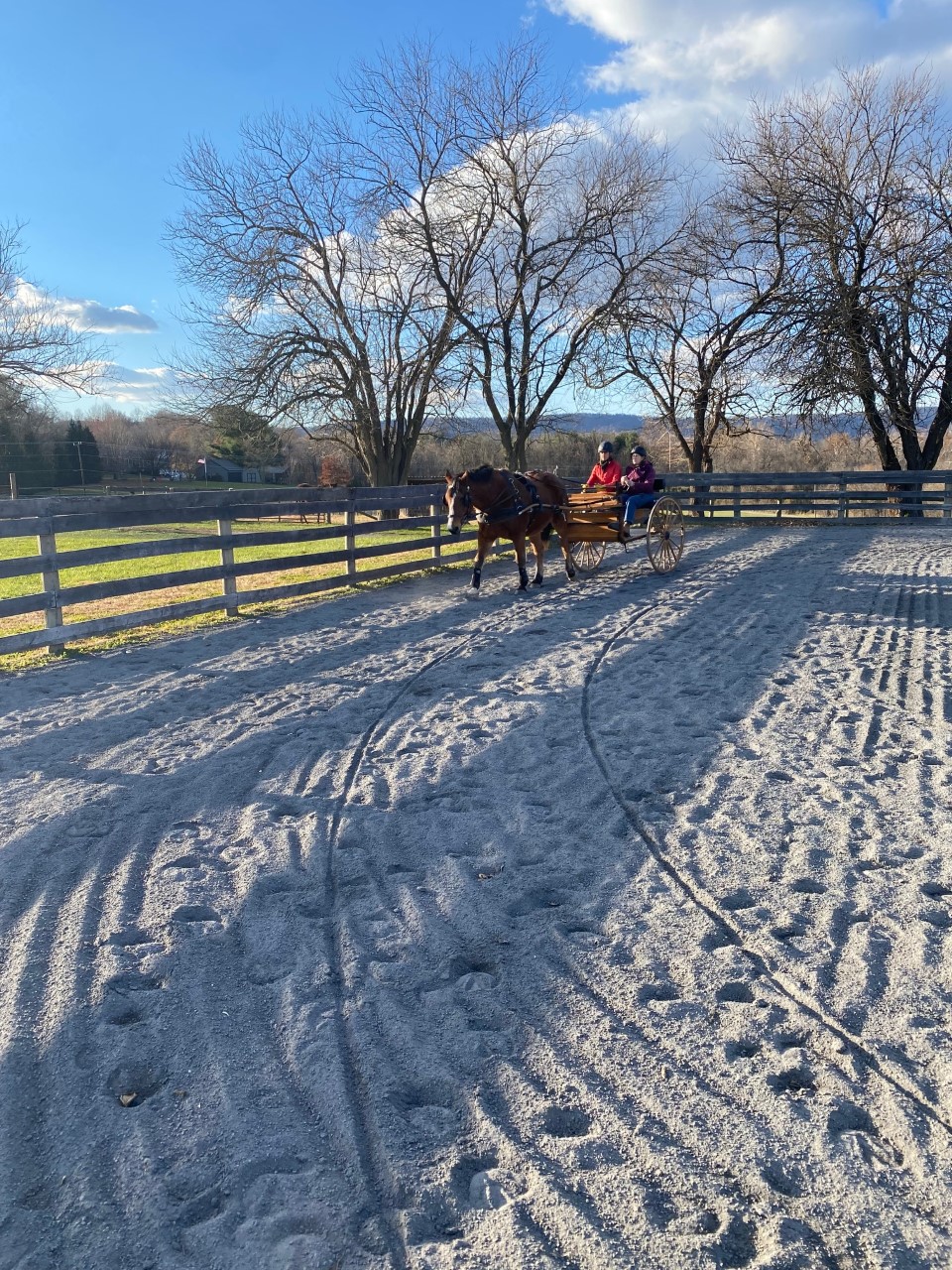
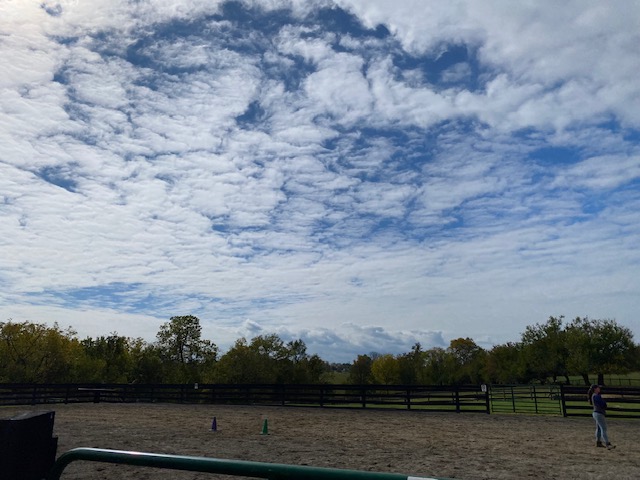
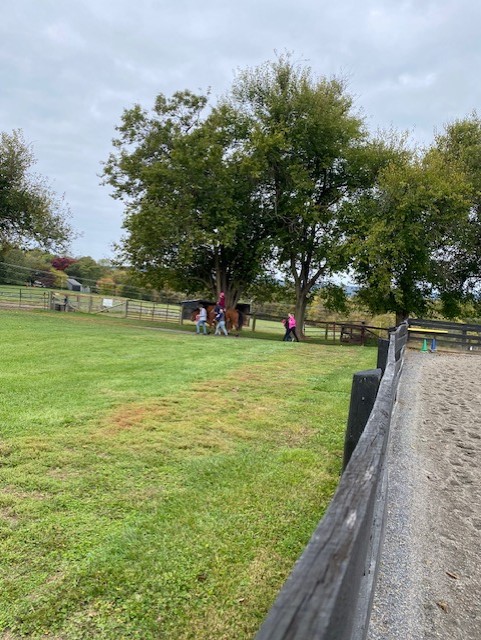
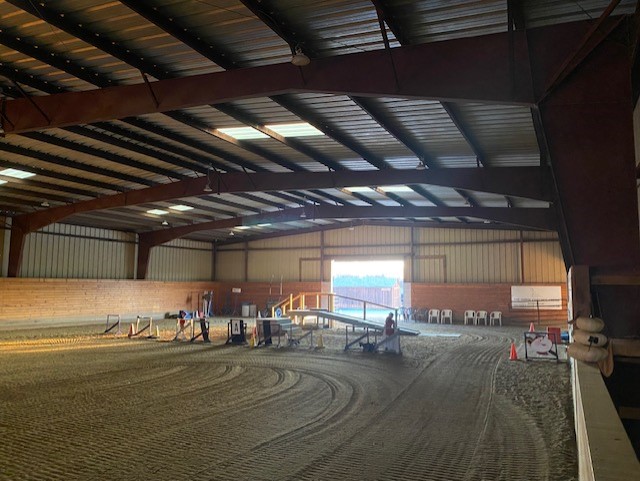
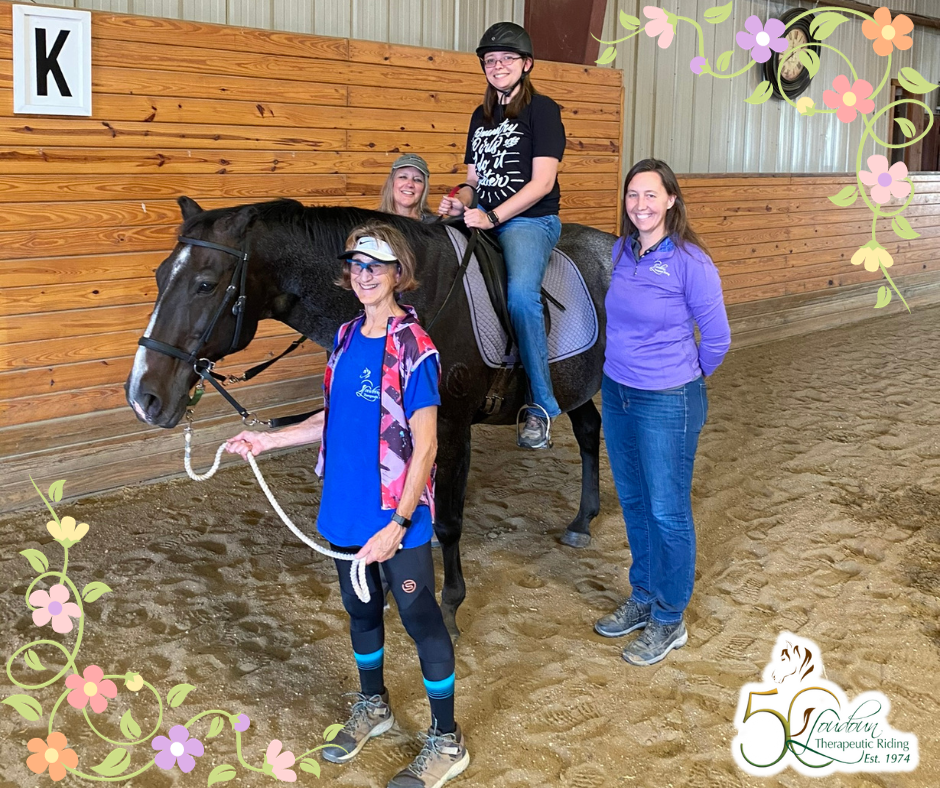
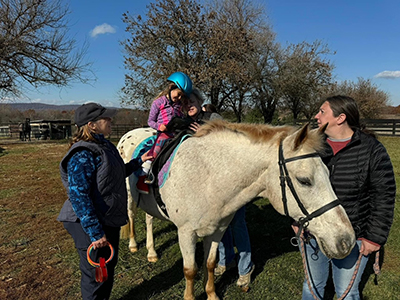
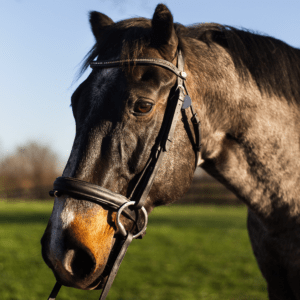




Are the organization's rules, restrictions and warnings (signage) conspicuously posted in easily accessible locations? Yes
Are the organization's emergency contacts, including veterinarian contact information, conspicuously posted in easily accessible locations? Yes
Are human and equine first aid kits easily accessible? Yes
Regarding all shelters where horses are housed including run-in sheds:
Do horses have assigned stalls in the barn/structure(s) or exclusively assigned shelter locations where they are separated from other horses with a barrier? Yes
How many hours per day, on average, are horses stalled or restricted to these sheltered exclusive shelter locations? 4-8
How often are the stalls/shelters cleaned, i.e., kept in good repair and free of standing water, accumulated waste, sharp objects and debris? 6-7 Days a Week
Do all stalls/shelters allow horses to lie down, stand up and turn around and provide protection from inclement weather (wind, sleet, rain, snow and extreme temperatures)? Yes
Are stalls/shelters kept in good repair, with adequate ceiling height, and free of standing water, accumulated waste, sharp objects and debris? Yes
Are floors constructed and maintained for both good drainage and traction? Yes
Is there a ventilation and circulation system in place to allow free flow of air to control temperature, and humidity, and to prevent air stagnation? Yes
Is wiring inaccessible to horses and maintained for safety in all areas of facility? Yes
Are fire prevention/protection measures (fire alarms, extinguishers and sprinkler systems) maintained and in good working order? Yes
Is there adequate lighting to ensure safety in all areas of facility? Yes
How many hours per day, on average, are horses turned out:
Equines are out 16+ hours per day
Equines are out 24/7 except they are brought in if there is inclement weather
Equines are out 24/7 except when they are used for the conduct of the organization's programs
The following describes the pastures at this facility:
A dedicated staff person(s) is responsible for pasture management
All pastures are fenced to prevent escape or injury
Electric fencing is used; electric wires or tape fence are visibly marked
Fencing checks, such as broken or missing planks, loose fence posts, exposed or loose nails, detached wires, etc., are done regularly
Pastures are rotated
Pastures have natural protection for equines (i.e., trees)
Pastures have man-made protection for equines (i.e., shelters)
This facility does not have pastures where equines can graze on pasture grass
This facility has a written plan in place for pasture management, which includes guidelines for seeding, fertilizing, irrigation, mowing, dragging, harrowing, manure removal, removal of debris, the control of poisonous plants, and a schedule for cleaning
Barbed wire is used for fencing
The following describes the turnout areas other than pastures at this facility:
A dedicated staff person(s) is responsible for the maintenance of turnout areas
All turnout areas are fenced to prevent escape or injury
Turnout areas have man-made protection for equines (i.e., shelters)
Fencing checks, such as broken or missing planks, loose fence posts, exposed or loose nails, detached wires, etc., are done regularly
This facility does not have turnout areas
This facility has a written plan in place for the maintenance of turnout areas, which includes a schedule for cleaning, manure removal, and dragging
Barbed wire is used for fencing
Electric fencing is used; electric wires or tape fence are visibly marked
The following policies and procedures are in place at the facility to restrict public access and to keep horses safe:
The property owner, staff member or caretaker lives on the premises and ensures that public access is restricted and is responsible for the security of the facility and equines
There is a practice in place to monitor equines overnight
By Appointment Only signs are posted.
Hold Harmless signs are posted
Authorized Personnel Only signs are posted
Entrance gates are locked at night
Visitors are only permitted at specific times
Visitors are only permitted in specific areas
The property is fitted with motion lights
The property is fitted with a security system that is monitored internally by staff (or the property owner)
The perimeter of the property is fully fenced
A security guard is present at night
No Trespassing signs are posted
The property is fitted with a security system monitored by police or a professional service
Equine Care/Emergency Preparedness: Loudoun Therapeutic Riding Foundation, Inc. (*Main) 2026 and 2025 This section is required.
Horse Health Care/Barn Management Records: What system is used to collect and store health/horse care records?
Onsite computer with cloud-based backup storage system
Our organization utilizes a software application to maintain records
The following items are consistent with our feed management plan and practices:
Equines are provided with individualized feeding plans, including supplements, according to the equine's age, breed/type, condition, size, work level and any health issues, consisting of nutritious food provided in sufficient quantity and access to adequate natural forage, or be fed daily, or as recommended by the organization's veterinarian
Equines are fed grain in individual stalls
Staff and/or volunteers are trained in proper feed measurements and protocols and observed periodically to ensure they are feeding correctly
The feed chart is centrally located and updated as needed
The area(s) where hay, feed, grain, and supplements are stored are kept clean, free of debris and chemicals, and protected from weather and other animals in rodent-proof and mold-proof containers and grain bins
Feed, supplements and hay types are clearly labeled
Water sources, i.e., buckets, troughs, automatic waterers, etc. are kept clean, free of contaminants, debris and chemicals, protected from weather and other animals, and be positioned or affixed to minimize spillage.
Medications are kept in a secure area
Feed plans are determined in consultation with a veterinarian
Supplement plans are determined in consultation with a veterinarian
Equines are fed grain in groups
Is clean, potable water available at all times for all equines? Yes
Hoof Care: How often is hoof care provided for each equine? Every 4-8 weeks and when an issue arises
Dental Care: How often is dental care provided for each equine? Annually and when an issue arises
Horse checks: How often are equines visually and physically checked by personnel at the facility? Every day or 6 days a week
Our organization has the following parasite and fly/insect control protocols in place, including remedies used to control flies and insects:
Our organization follows the parasite control guidelines of our veterinarian, including fecal testing and de-worming
Fly/Insect Control Remedies:
Fly Spray Repellent
Fly Masks
Fans
The following represent the biosecurity practices in place at facility:
Our organization follows the biosecurity guidelines of our veterinarian
Sick, affected and/or quarantined equines do not have contact with other equines or other animals
The organization has a written biosecurity plan
Staff are trained in best practices related to biosecurity
Volunteers are trained in best practices related to biosecurity
A specific individual is trained and assigned to care for sick, affected and/or quarantined equines
Sick, affected and/or quarantined equines are cared for last if the caretaker must also care for healthy equines
Restricted access signs are posted at primary points of access to sick, affected and/or quarantined equines
Hand sanitizers are available at all primary points of access to sick, affected and/or quarantined equines
Footbaths are available at all primary points of access to sick, affected and/or quarantined equines
Manure and bedding from sick, affected and/or quarantined equines is removed from the facility - not put in open air piles, and not spread on pastures
Quarantine areas, such as stalls, aisle ways, paddocks, and common areas, are cleaned (and needed, disinfected) after conclusion of the quarantine.
Trailers/vans used by sick, affected and/or quarantined equines are cleaned and disinfected after each use and cleaning takes place away from where equines are sheltered
Equipment used by sick, affected and/or quarantined equines is not shared
Equipment used by sick, affected and/or quarantined equines is cleaned of organic debris and disinfected after each use
Latex gloves, or equivalent gloves, are worn when working with sick, affected and/or quarantined equines
Equines are not quarantined on arrival.
Additional information on biosecurity:
LTR adheres to the above biosecurity practices and is included in our written equine welfare policies.
The following represent the manure removal practices in place at facility:
Manure is piled in an area where equines are not located
Manure is hauled, sold or given away
Our organization adheres to the manure management guidelines set by the state, local authorities, and/or our organization's veterinarian
Manure is stored in dumpster(s)
Manure piles are covered
Manure piles are composted or spread on pastures
The following steps are taken to help staff and volunteers readily identify each horse on the property:
Equines are assigned the same exclusive stall/shelter location each day
Name plates are located on the stall/shelter location
Equines wear halters with nametags
A notebook or binder with photos and information on each equine is easily accessible
A map/diagram is posted showing the location of each equine with equine names and photos
Equine photos and profiles are available on the website
Staff and volunteers are provided with an information packet with equine profiles, including photos and detailed descriptions
Staff/volunteers are provided training on conformation, markings, colors, and breeds
Team leaders work with new staff/volunteers until they are able to identify the equines
Photos are located on the stall/shelter location
Our organization has the following policies and procedures in place pertaining to tack, apparel and equipment:
Saddles are shared
Blankets, sheets and turn out apparel are fitted and utilized for each equine appropriate to the equine's needs and the weather conditions
Blankets, sheets and turn out apparel are cleaned regularly as needed
Riding Tack is always cleaned after each use
Riding Tack is inspected for overall working condition before each use by trained personnel
Riding Tack is assessed for fit before each use by trained personnel
Riding Tack is assessed for fit by trained personnel when an equine's body condition changes
Riding Tack is assessed for fit by trained personnel when an equine's disposition changes
This facility enlists the services of a professional saddle fitter at least once a year
Assigned riding tack is clearly labeled
Riding Tack is stored in a climate-controlled location
Helmets are shared
Helmets are cleaned/disinfected after each use
Helmets are replaced after a fall
Helmets are replaced at least every five years.
All equines have specifically assigned apparel, equipment and tack (saddles/bridles if ridden) that is not shared
Saddle pads are shared
Bridles are shared
Bits are shared
Blankets are shared
Sheets are shared
Turnout apparel is shared
Halters are shared
Riding Tack is always cleaned at least weekly
Riding Tack is cleaned only when needed
No equines are ridden; saddles, bridles, etc. not applicable.
Emergency Preparedness: Loudoun Therapeutic Riding Foundation, Inc.: *Main This section is required.
The following plans, policies, and procedures are in place at the facility to handle emergencies and address weather related issues, fire safety procedures, and/or any additional hazardous scenarios the facility could potentially experience:
Emergency procedures are posted prominently
The facility owns or has access to a generator
The facility maintains at least two weeks of hay, feed, shavings and medications
The facility collects and maintains medical information from staff, volunteers, and clients
The facility maintains appropriate liability and/or workers' compensation insurance
The organization has a written emergency preparedness/safety plan (EPP)
Local fire department and/or the state's emergency planning department procedures
Medical emergencies for clients, staff, and volunteers
Medical emergencies for equines
Power outages
Fire
Natural Disasters - thunderstorm, hurricanes, earthquakes, tornados, etc
Protocols to notify emergency personnel
Building/facility exit plans
Evacuation plans
Terrorist attacks
The facility follows the specific procedures to help PREVENT emergency situations:
Smoking is strictly prohibited
NO SMOKING signs are posted prominently
Hay is stored away from permanent or temporary structures where equines are stalled
Permanent or temporary structures where equines are stalled are kept free of dust, cobwebs, trash, cleaning rags, and other flammable items
Aisles and doorways are kept clear
Heaters with automatic shutoff settings are used
How often are the following checked or performed?
Fire Extinguishers are checked: Annually
Smoke detectors are checked: Annually
Fence lines are checked: Weekly
Turnout Areas are checked: Daily
Sprinkler systems are checked: Not at all/NA
Fire drills are conducted: Annually
Review of safety protocols with staff are conducted: Annually
Review of safety protocols with volunteers are conducted: Annually
The Emergency Preparedness Plan is reviewed and updated: Annually
Equine Transportation: 6= Onsite: 1 (1 + 0) + Offsite: 5
2-horse van/trailer with truck:
1 Owned onsite 4 Access offsite;
4-horse van/trailer with truck:
1 Access offsite;
GOVERNANCE, MANAGEMENT & FINANCIAL REPORTING
Financial ReportingBudget: $500K to $1M
Month Fiscal Year Ends: 12
Type of Financial Reporting (Audit, Review, Compilation): Audit
Type of IRS Filing (990, 990-EZ, 990-N): 990
Governing Body:
Board meetings per year: 5
Number of Board Members: 11 Number of Voting Board Members: 11
Board Compensation:
Is the Board Chair compensated? No Is the Treasurer compensated? No
Are there any other Voting Board Members that are compensated? No
Board/Staff Relationships:
Are any members of the Board, Staff or Program Participants related to each other through family or business relationships? Yes
If yes, provide the name, title, responsibility and family/business relationship of each Board, Staff member and/or Program Participant.
Two Board Members (one treasurer and one at-large) are parents of a program participant.
Board/Staff Affiliations:
Are any Board members providing services to your organization or compensated by your organization, or are any Board members or staff members associated with and/or compensated by another organization with a relationship or business affiliation to your organization? No
Conflict of Interest:
Does your organization have a written conflict of interest policy that ensures that any compensated board member is a NON-VOTING (Independent) board member or that any compensated board member or any board member related to a compensated staff member, independent contractor, or any related board members, or any individual or organization that might benefit from a board decision, abstains from voting on issues impacting such compensation and requires officers, directors or trustees, and key employees to disclose at least annually in writing interests that could give rise to conflicts? Yes
Compliance:
Below is a list all local, state and federal licenses held by the organization, and/or accreditations or compliances with the published standards of an accrediting organization, if applicable: No state, local, federal licenses required. LTR is a Professional Association of Therapeutic Horsemanship, Intl. (PATH Intl.) Premier Accredited Center (PAC) since June 1995. Most recent re-accreditation was June 2019. June 2024 - Due for re-accreditation. NOTE: Awaiting a re-accreditation date from PATH Intl. likely in 2026 due to backlog of centers needing in-person site visits.
Organization documents available on our website:
Most recent IRS Form 990
Organization documents available on request:
Most recent Financials
Most recent IRS Form 990
Most recent Annual Report
Equine Intake Guidelines
Adoption/Foster Agreement
Volunteer Handbook
Staff Handbook
Bylaws
Staff & Volunteers:
Chief Staff Officer (CSO): Laura Smith, Executive Director
Employees/Independent Contractors: Full-Time: 7 Part-Time: 7 Volunteers: 175
Staff Recruitment, Screening and Training processes including employees and independent contractors:
Prospective staff/independent contractors complete a written application/agreement
Our organization has a practice in place to ensure that the organization has sufficient knowledge of the background of prospective staff and independent contractors that may impact the safety of your clients and your horses, such as whether prospective staff/independent contractors serving in the capacity as staff have been convicted of a sexual offense or convicted for animal cruelty or neglect. Such practices must comply with local, state, and federal mandates.
Staff and/or contractors are required to complete a Liability Release/Hold Harmless Agreement
Staff and/or contractors are required to provide Emergency Medical Information
Staff and/or contractors are required to sign a Photo Release
Prospective staff/independent contractors are required to undergo a Background Check
Staff and/or contractors provide parent/guardian information if applicable
Staff and/or contractors carry current health insurance
Staff and/or contractors have a written job description
Staff and/or contractors are evaluated on an annual and as needed basis or with any change in their job description
Staff and/or contractors are updated on all the organization's policies and procedures on an annual and as needed basis or with any change in policy or procedure
Staff and/or contractors receive training that includes safety guidelines, confidentiality, equine handling, equine identification, and emergency procedures; additional training is job specific
Staff and/or contractors have a supervisor and is responsible for keeping their supervisor up to date on work related activities
The organization provides a handbook ((available either online or in print) to every member of the staff, including employees and/or independent contractors serving in staff positions;
The handbook includes information, such as hours of work, vacation, sick leave, dress code, cell phone usage, and the protocol for dismissal
The handbook is reviewed annually and updated
One or more staff members or contractors are trained in CPR and human first aid
One or more staff members or contractors are trained in equine first aid
Staff and/or contractors are subject to Random Drug Screening
Volunteer Recruitment, Screening and Training processes:
Prospective volunteers complete a written application/agreement
Our organization has a practice in place to ensure that the organization has sufficient knowledge of the background of prospective volunteers that may impact the safety of your clients and your horses, such as whether prospective volunteers have been convicted of a sexual offense or convicted for animal cruelty or neglect. Such practices must comply with local, state, and federal mandates.
Volunteers required to complete a Liability Release/Hold Harmless Agreement
Volunteers are required to provide Emergency Medical Information
Volunteers are required to sign a Photo Release
Prospective volunteers are required to undergo a Background Check
Volunteers provide parent/guardian information if applicable
Volunteers carry current health insurance
Volunteers have written job descriptions
Volunteers are evaluated on an annual and as needed basis or with any change in their job description
Volunteers are updated on all the organization's policies and procedures on an annual and as needed basis or with any change in policy or procedure
Volunteers receive training that includes safety guidelines, confidentiality, equine handling, equine identification, and emergency procedures; additional training is job specific
Volunteers are assigned a supervisor (staff member and/or senior volunteer) and is responsible for keeping their supervisor up to date on work related activities
The supervisor assesses the volunteer's abilities and assigns specific duties to the volunteer based on their skills
The organization records and maintains written attendance information and hours on every volunteer
The organization provides a Volunteer Handbook to every volunteer
The Volunteer Handbook (available either online or in print) includes volunteer-related information, such as hours of work, dress code, cell phone usage, and the protocol for dismissal
The Volunteer Handbook is reviewed annually and updated
The organization holds regular orientation sessions for volunteers and prospective volunteers that includes an overview of the organization, its mission, activities, volunteer responsibilities and expectations, safety guidelines, and a tour of the facility
Volunteers are subject to Random Drug Screening
Additional explanation regarding governance, staffing and volunteer practices or further explanation of the answers above.
The Donor Bill of Rights - Posted on LTR website for transparency
Philanthropy is based on voluntary action for the common good. It is a tradition of giving and sharing that is primary to the quality of life. To assure that philanthropy merits the respect and trust of the general public, and that donors and prospective donors can have full confidence in the not-for-profit organizations and causes they are asked to support, we declare that all donors have these rights:
I. To be informed of Loudoun Therapeutic Riding’s mission, of the way the organization intends to use donated resources, and of its capacity to use donations effectively for their intended purposes.
II. To be informed of the identity of those serving on Loudoun Therapeutic Riding’s governing board, and to expect the board to exercise prudent judgment in its stewardship responsibilities.
III. To have access to Loudoun Therapeutic Riding’s most recent financial statements.
IV. To be assured their gifts will be used for the purposes for which they were given.
V. To receive appropriate acknowledgement and recognition.
VI. To be assured that information about their donation is handled with respect and with confidentiality to the extent provided by law.
VII. To expect that all relationships with individuals representing Loudoun Therapeutic Riding of interest to the donor will be professional in nature.
VIII. To be informed whether those seeking donations are volunteers, employees of Loudoun Therapeutic Riding or hired solicitors.
IX. To have the opportunity for their names to be deleted from mailing lists that Loudoun Therapeutic Riding may intend to share.
X. To feel free to ask questions when making a donation and to receive prompt, truthful and forthright answers.
© Copyright 2018 EQUUS Foundation 151 5.00
